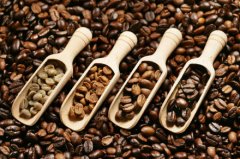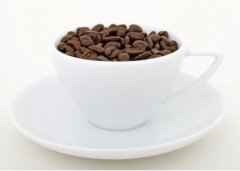Coffee and its products-- terminology (3)

Appendix A
(appendix to the standard)
Hanyu Pinyin Index
A F
Arrabal Coffee 6.1.2 moldy beans 3.18
Concave grain 3.3 fermentation degumming 4.2.3
Flotation 4.2.1
B G
White coffee beans 3.21
Semi-black bean 3.10 dried fruit 2.2.7
Roast 4.5 dry clothes 2.2.4
Roasted coffee 2.1.19 dried beans 3.17
Flat bean 2.1.8 dry processing 4.1
Meat stripping 4.2.2 dry processing of coffee beans 2.1.14
Insoluble content 5.9 high-variety coffee 2.1.5
Pulp 2.2.2
C H
Blending 4.6
Blend sample 5.4.6 Sponge bean 3.12
Worm-eaten beans 3.7 black coffee beans 3.9
Smelly coffee beans 3.14 amber beans 3.22
D flowering pea 3.16
Regained coffee beans 2.1.16
Dazhi 3.27.4 mixed sample 5.4.5
Boulder 3.27.1 J
Large parcels 3.27.7.1
Elephant bean 2.1.10 machine damaged bean 3.19
Large seed coffee 2.1.4 base sample 5.4.4
Bag 5.11 deformed beans 3.6
Coffee beans with shells 3.28 lose weight by heating 5.8
Coffee beans with clothes 2.2.5 K
Drying of clothed coffee beans 4.2.5
Light coffee beans 2.1.13 Coffee 2.1.1
Mix 4.4 coffee beans 2.2.11
Freeze-dried coffee 2.1.22.3 coffee shell 2.2.6
Single bean 2.1.9 coffee powder 2.2.20
Multi-layer sampler 5.4.2 Coffee fruit 2.2
E Coffee Oil 5.1
Caffeine 5.3
Secondary granulated coffee 2.1.22.2 coffee berries 2.2.1
Coffee drink 2.1.24 shelled 4.1.2
Coffee flavor 5.2 decaffeinated coffee 2.1.23 coffee beans 3.4 W
Coffee sampler 5.4.1
Drying of fresh coffee fruit 4.1.1 extraneous impurities 3.27
Shelled 3.1 immature beans 3.11
L stinky bean 3.26
Waxy bean 3.23 X
Particle size analysis 5.10 washing 4.2.4
M washed coffee beans 2.1.15
Box 5.12
Grinding 4.7 twigs 3.27.6
P Pebble 3.27.3
Small parcels 3.27.7.3
Polished coffee beans 2.1.17 small seed coffee 2.2.2
Spray-dried instant coffee 2.1.22.1 olfactory test 5.5
Q Y
Light color bean 3.25 sample 5.4.3
Light bean 3.13 silver skin 2.2.9
Unclothed 4.2.6 insecticidal coffee beans 3.8
R coffee beans with live worms 3.8.1
Coffee beans with dead insects 3.8.2
Naked eye examination 5.6Z
S diameter 2.1.11
Sieve residual 2.1.18 medium branch 3.27.5
Screening grade 4.3 stone 3.27.2
Raw coffee 2.1.7 clods 3.27.7.2
Wet processing 4.2 medium seed Coffee 2.1.3
Wet processing of coffee beans 2.1.12 seed skins 2.2.8
Laboratory samples 5.4.7 kinds of clothing 2.2.3
Moisture content 5.7 kinds of clothing 3.2
Instant coffee 2.1.22 seed 2.2.10
Sour coffee beans 3.15 brown coffee beans 3.20
Chopped beans 3.5
T
Carbonized beans 3.24
Coffee extract 2.1.21 clods 3. 27 . seven
Important Notice :
前街咖啡 FrontStreet Coffee has moved to new addredd:
FrontStreet Coffee Address: 315,Donghua East Road,GuangZhou
Tel:020 38364473
- Prev

Coffee and its products-- terminology (2)
Pulper--mipped bean cut or scraped wet processed coffee beans, often with brown black scars. 3.20 Brown coffee beans brown bean brown-black coffee beans. 3.21 White coffee beans white bean are simply called white beans, that is, coffee beans with a white surface. 3.22 Amber beans amber bean yellow coffee beans
- Next

Coffee Health knowledge Coffee is a good helper to improve women's libido
Coffee has become a more and more popular drink in recent years, and many people have even formed the habit of drinking a cup in the morning. But you know, this mellow liquid is also a good helper to improve women's libido. Caffeine has an aphrodisiac effect on women, according to a new study published in the journal Pharmacology, Biochemistry and behavior, the BBC reported recently.
Related
- Beginners will see the "Coffee pull flower" guide!
- What is the difference between ice blog purified milk and ordinary milk coffee?
- Why is the Philippines the largest producer of crops in Liberia?
- For coffee extraction, should the fine powder be retained?
- How does extracted espresso fill pressed powder? How much strength does it take to press the powder?
- How to make jasmine cold extract coffee? Is the jasmine + latte good?
- Will this little toy really make the coffee taste better? How does Lily Drip affect coffee extraction?
- Will the action of slapping the filter cup also affect coffee extraction?
- What's the difference between powder-to-water ratio and powder-to-liquid ratio?
- What is the Ethiopian local species? What does it have to do with Heirloom native species?

